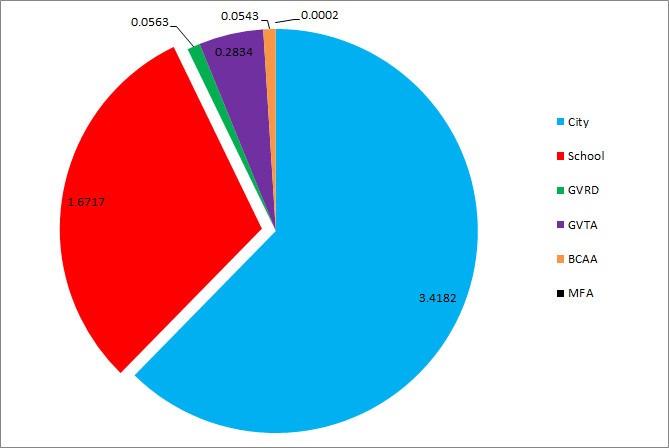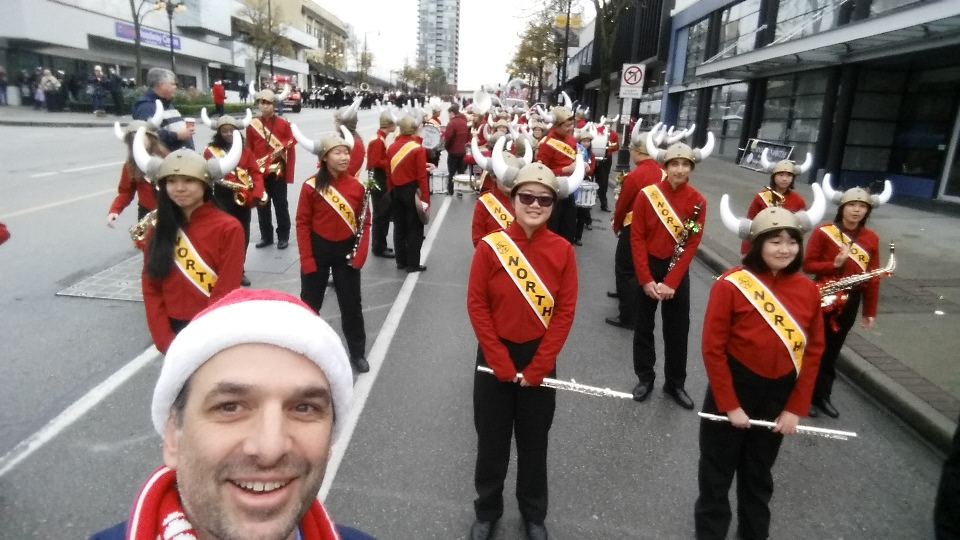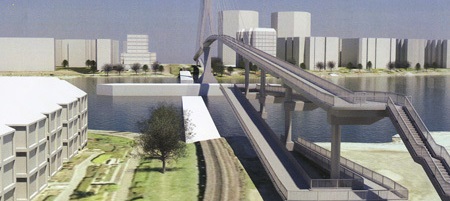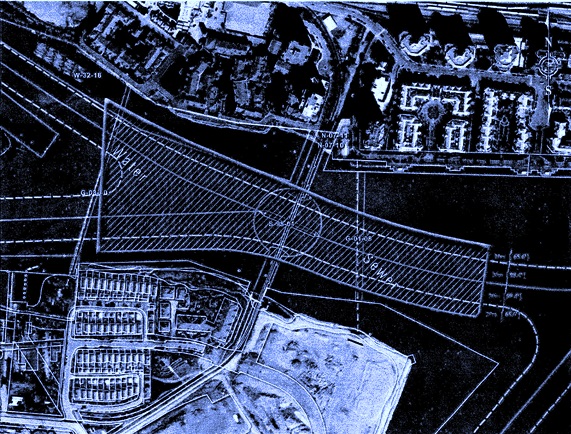The November 7th meeting had an insane Agenda. There were so many items, and a high potential for many Public Delegations, that we took the pragmatic decision to table a number of items that were not time-sensitive, but deserved a bit of discussion by Council (and would not, therefore, be appropriate for the passing on Consent). Still,we were at it until about 11:30 at night, which makes it (I think) the longest meeting not to feature a Public Hearing in my two years on Council.
We started with two Opportunities to be Heard:
Development Variance Permit 00608 for 725 Fifth Street
I mentioned this DVP last meeting, where the owner wishes to legalize a permitted secondary suite, but the requirement for an off-street parking spot would necessitate the removal of a Bylaw-protected tree. Instead, they are asking for a variance removing the requirement for the off-street parking spot, in exchange for permanent protection of the Tree.
Although no-one came to speak to this variance, we received two written submissions from neighbours opposing it over concerns about the availability of street parking on the block of Fifth Street.
A quick Google Street View survey shows the 22 houses that face the 700 block of Fifth Street have a total of 23 closed garages and/or carports and enough off-street parking pad space for 30 or more cars (not counting the well-used dozen or so parking pads on the City Boulevard). I just can’t see a lack of parking on this street to the scale that I a bylaw-protected tree should be removed.
Council voted to approve the variance.
Development Variance Permit 00611 for 337 Fourth Street
Similarly, I also mentioned this similar DVP last meeting. The owner of this house also wants to protect two trees on their property and a boulevard tree by not providing off-street parking for their legal secondary suite. In this case, the off-street spot probably would not change the amount of parking available because of the need to build a driveway would result in the loss of at least one street parking spot.
We received one written submission supporting the variance, and a neighbour spoke in support of the variance (and was very complimentary to both City Staff and the Proponent in describing their opportunity to comment and provide feedback to the DVP).
Council voted to approve the variance.
The following items were moved on consent:
Designations to Act for the Director of Development Services from Time to Time
This item formalizes some parts of the chain of authority in the City planning department. We have Bylaws that give certain powers to the person designated as the Director of Development Services, but don’t have a formal succession process if the Director is away for an extended period of time. We now do!
Rescindment of Bylaws Involving Racial Discrimination
New Westminster is 150 years old, and that means we have 150 years of old Bylaws, many of them long forgotten, but still (apparently) on the books. The Provincial Government was doing reviews of old Bylaws and discovered a couple from 1929 New Westminster that allowed a paper mill to operate on City lands as long as they only hire white workers. Council moved to rescind these old Bylaws.
To put this in context, 1929 was a time of lengthy economic stagnation and sudden depression, where placing the blame on immigrants and foreigners was empowering rising fascism to replace liberal democracy, even in the most advanced nations… so nothing like today.
437 Seventh Street: Heritage Designation Repeal Bylaw for First and Second Reading
Back in 2010, this property owner went through a Heritage Revitalization Agreement process, agreeing to exterior renovations in exchange for zoning considerations that would permit more units in the building. The owner never executed the renovations requested, and therefore never received the rezoning benefits. The owner therefore wants to repeal that agreement and keep the house as the duplex it currently is.
Council moved to give this repeal first and second reading.
318 – 328 Agnes Street: Housekeeping Amendment Bylaw to Amend the CD-63 Zone to Allow for a Change in the Make-Up of Units – Bylaw for First and Second Readings
As sometimes happens, things shifted a bit in this development between approving the development plan and getting various building approvals during the building phase. In this case, a few units had to be shuffled around to make the building work. The development still has the same number of suites, but one 2-bedroom suite was shifted from one building to the other, and there is a very slight (<1%) increase in site coverage. Not a big problem, but it means we need to revise our Zoning Bylaw and Housing Agreement (as it is secured market rental building).
628 and 638 Columbia Street: Development Variance Permit 00617 for Temporary Sales Centre – Consideration of Issuance
Bosa is planning to build two buildings on parking lot between the Pier Park and the Fraser River Discovery Centre, and wants to build a sales centre for the development on the old Copps Shoes site on Columbia Street. This would require a DVP to allow the construction of a temporary building that does not reflect the zoning for that property.
As there doesn’t seem to be any rush by the owners to develop the fire site, this will at least activate the space for a couple of years. I am more excited about the opportunity to activate the back part of the property – the south half that faces on to Front Street. This has the opportunity to be a great temporary public space that supports the other businesses along the Mews and downtown, and compliments the Pier Park.
Street and Traffic Bylaw No. 7664, 2015
The Street and Traffic Bylaw that regulates all City roads and parking spots is finally being updated. This process has taken a while, and review by the Ministry of Transportation (a necessary step) took longer than anticipated, but we are finally ready to approve this cleaner, more logical, bylaw.
My only disappointment is that City Councillors still aren’t able to hand out tickets when we see people driving or parking like idiots. Dare to dream…
Application for Grant Funding to the Clean Water & Wastewater Fund (CWWF)
The City is applying to senior governments for grants to help pay for sewer separation and pump station projects. Fingers crossed!
Application for Grant Funding to UBCM Asset Management Planning Program
We are also applying to UBCM for a grant to help fund our ongoing Asset Management program. Keep your fingers crossed!
Users Fees and Rates Review Bylaws for 2017 for Three Readings
This Bylaw formalizes the rate changes we discussed at Council on October 24th.
1023 Third Avenue: Heritage Revitalization Agreement and Heritage Designation – Bylaws for First and Second Readings
This project the Brow of the Hill takes an innovative approach to preserving a Heritage House and building some infill density on a large lot. The project will be going to Public Hearing on November 28. C’mon out and tell us what you think.
217 Ninth Avenue: Development Variance Permit for Parking Space Exemption for Secondary Suite – Preliminary Report
Similar to the items we covered in the Opportunity to be Heard portion of the meeting, this owner also wants to have a legal suite and not provide extra off-street parking to protect trees. There will be an Opportunity to be Heard on tis application on November 28, C’mon out and tell us what you think.
(ACTBiPed) Recommendation: Pattullo Bridge Rehabilitation Project Thank You to Go Traffic and TransLink
The members of the City’s Advisory Committee on Transit, Bicycles and Pedestrians recognized that the teams of traffic control persons who spent the summer managing the traffic disruptions around the Pattullo partial closures had a tough job, and did it with exceptional patience and professionalism. The ACTBiPed didn’t want to let that pass without them being acknowledged for the great work they did, and thanking TransLink for providing support to the city to help that program be successful. Council will send thanks.
We then had two Presentations from Staff:
Draft 2017-2021 Financial Plan – Utilities
Each year as part of our budgeting process, we review Utility Rates for the coming year and the anticipated rates for the next 5 years. As usual, this is a mix of good and bad news.
Electrical: going up 3.5% next year, 3.0% in years 2-5: This cost increase is driven almost exclusively by equal increases in the cost of purchasing electricity from BC Hydro. The City’s policy is to match BC Hydro rates on a system-wide basis.
Water: 4% a year: Again, this relates directly to the cost of purchasing water from Metro Vancouver. We are still waiting to have the discussion about water conservation measures that were requested by Council back in February.
Liquid Waste: 7% a year: This is clearly the area of most concern. The region is going to need to spend a bunch of money on sewage treatment plant upgrades in the decade ahead, and in New West it is very difficult for us to avoid these costs, because we still have a significant amount of combined-flow sewers, where storm water mixes with our sewage, and it all goes to the treatment plant.
The capital investment in sewer separation that didn’t happen 20 or 30 years ago (in most cities) is costing us a fortune now. To accelerate our sewer separation program would be really expensive for the City and for homeowners, but the alternative is that we continue to pay the cost of shipping storm water to the sewer treatment plant, and paying for that privilege.
Solid Waste: 1% a year: The solid waste story is obviously one of success, with rate increases at or below the inflation rate. This is a result of several years of aggressive work to reduce waste and separate waste at the source to get the most value out of recycling. Those investments are paying off.
Brunette Avenue Interchange Public Consultation
The Ministry of Transportation is doing public consultations on a replacement project for the Brunette Interchange that somehow includes a return of the United Boulevard Extension. I attended the public Open House in New Westminster, and it was very well attended (something like 400 people), but with little forewarning and some significant data gaps, it was difficult for people to generated much useful feedback. I hope that people will take the time to absorb that information, understand the issues being discussed, and provide feedback to the on-line portal.
I have a lot to say about this, but will do so in a follow-up post to save a bit of space here for other business (this report is looking to be over 3,600 words already, Aye Carumba!).
In the end, Council moved to invite Coquitlam Council for a council-to-council meeting to discuss the project, and identify potential shared interests, which should be interesting.
The following items were Removed from Consent, and discussed after a fairly lengthy Public Delegation period.
Public Art Projects in partnership with Capture Photography Festival
There are two locations in the City, one Downtown and one Uptown, where large blank walls provide opportunities for Public Art. The Capture Photography Festival is happening around the Lower Mainland next April, and a part of that festival, a photography-based project on these two locations will be installed. Council agreed with the Public Art Advisory Committee to spend $60,000 out of our Public Art Reserve Fund to install these pieces in the spring.
Early Grant Approval for the Hyack Grand Prix Bike Race
I I am very hopeful that we are getting things approved early here so this event can go on. Having a bike race in Uptown/Queens Park during the Hyack Festival week would be a great event. Keep those fingers crossed.
Business Case and Next Steps for Sapperton District Energy System
I am happy to see this project moving forward. Sewer heat recovery is more capital-intensive than wood waste incineration, but provides some significant environmental benefits and the risks are better known as we are not attaching our long-term planning to an uncertain fuel supply. This will be almost carbon-free energy, is a great synergy between the City, the development community, and the RCH expansion. Through it, we are helping Fraser Health reduce their greenhouse gas emissions, making development of our community more energy and GHG efficient, and using a waste energy supply that is modular and expandable with increased need.
The capital cost up front is significant but we need to think in 30-year+ timelines if we are going to build infrastructure that moves us beyond carbon-intensive energy sources. We have been very conservative in our cost estimates here, and have reason to believe the cost-benefit ratios will outperform our estimates here.
215 Manitoba Street (Queen’s Park): Heritage Alteration Permit HER00577 to Permit Demolition
The situation with heritage preservation in Queens Park is obviously very sensitive right now. With a Heritage Control Period continuing for another 8 months, demolition requests for buildings more than 50 years old have to come to Council, and Council has the option to say no. As most of Council are not heritage professionals, we have a process developed that can assess whether a house being proposed for demolition has significant heritage value and potential for preservation.
This house has low heritage value according to the assessments done, and is in deteriorated condition. Neither the Heritage Commission nor our technical review panel recommended that the house be preserved. I am reasonably convinced that this demolition would not represent a loss to the heritage values of Queens Park, and I therefore voted to approve the demolition.
105 College Court (Queen’s Park): Heritage Alteration Permit
HER00581 to Permit Demolition
This application is similar to the above one, but differs in a pretty significant way. Based on the reports, the house has moderate heritage value, especially in how it impacts the streetscape of College Court, and has significant heritage assets intact. As a summary, it would not be particularly difficult or expensive to upgrade the few issues in the house while preserving the heritage value. Therefore I could not vote to approve the demolition of this house during the Heritage Control Period.
This house also raises some interesting discussions about Heritage in Queens Park in that it is a Mid-Century Modern style, more than 50 years old, but not the first thing you think of when you say the words “Queens Park Heritage home”. I don’t even think we have existing guidelines for the preservation and protection of Mid-Century Modern homes.
Clearly, there is a lot of work to do, and a lot of discussion yet to have in the neighbourhood, about Heritage Preservation and the goals of the neighbourhood in a Heritage Conservation Area.
Internet Service Provider Agreement with Wi-Band Communications
A fifth small telecom company is interested in providing service through our dark fibre network (Bridg Net), this one a business-specific gigabit provider who also provides bargain rates for less-than-gigabit Wi-band (line-of-sight transmission by radio frequency) to expand service away from the fibre trunk line itself. Good news!
Official Community Plan Review: Summary of Our Future City Events and Land Use Designation Map Discussion
I am really happy that the OCP process is moving onto the next phase. We have beaten the Land Use Plan discussion to death. I attended a couple of the open house events during this last round, and was again impressed and amazed at how many people in New Westminster showed up, spent a couple of hours digging into the details of these plans. I heard great discussions, a few disagreements, and a lot of peer-to-peer learning and sharing. Now is time for our staff to get their weekends back.
We had more than an hour of discussion and I don’t want to cover it in any kind of detail here (you can pull up the video here and skip ahead to 4:22:00 to hear this), and I am sure I will be writing more on this in the coming weeks, but I will cover a few of the key points Staff asked Council to comment upon, and my take on them (remember, this blog is my voice only, not the opinion of Council or of the City – not all of Council necessarily agrees with me on these points).
Bent Court: This area is interesting, a mixed residential and commercial district that is zoned for high-rises, although it is unlikely that anyone would build to that scale here. Staff is recommending a special approach here that can incentivize the preservation of the heritage homes, whether they be used for residential or commercial.
Sharpe Street: This small light-industrial area along the north side of Stewardson is underperforming for a variety of reasons. We had a couple of owners fo the lots here ask for a rezoning to give them the ability to sell for development. The City does not have much light industrial land, so Council was generally reluctant to let any of it go, but I find it hard to envision this being improved for industrial use as the site access is so constrained, especially for trucks. It is only 400m from 12th, and 50 m from frequent bus service at 6th, so I could see a little cluster of townhomes/row homes or mix of moderate density housing here.
Uptown Density: There is some interest reflected in discussion with the Uptown BIA to see more density adjacent to the Uptown commercial area. I am not opposed to this idea, but am cautious about the potential impact of building new high rises where we currently have affordable rental properties. If we were to move towards replacement of these buildings, I would want to know there was adequate access to affordable housing for the people who live there now – mostly low-income earners and lots of seniors who need their connection to Uptown services. We don’t want a Metrotown renoviction situation here in New West.
Brow of the Hill Townhouses: I am generally in favour of more flexibility in development in the Brow neighbourhood. I love the Brow for its housing diversity, my SFD house is across the street from a 3-story walk-up, there are townhouses behind me and a high rise one block over. It is a really walkable neighbourhood with a lot of amenities, we need more of the “Missing Middle” here, but also need to be careful around the remaining pockets of heritage homes.
City-Wide Townhouse: There were several recommendations to open up more areas to townhouse or rowhouse type development, not just on busy streets, but also the block back on the quieter streets that are perhaps more family-friendly, but still a short walk to transit and amenities. I am in favour of the recommendations made by staff – the think overall we need to assure we are doing everything we can to promote a variety of housing types and get off of this tower vs. SFH density discussion. The Missing Middle should be our goal here.
Special Employment Area: The opportunities for a significant amount of job-generating commercial and office space around the expanded RCH need ot be supported. The retail core of Sapperton will benefit, the economy of the city will benefit, supportive businesses will make RCH run better, and the entire neighbourhood will become more vibrant.
I will be writing more on the OCP process as we go along, but I am pretty proud of the work this City has done to this point. Our Planning staff have worked long hours, had thousands of one-on-one conversations, produced an amazing amount of public input, and really engaged the community. We have a few people not happy about a few details of the draft Land Use Plan, and that is the nature of the beast, but the aggregate of the feedback is that we are pretty close to the Goldilocks zone for land use changes. We’ll be seeing the final plan in December, but I don’t think there will be too many surprises from here on in.
Finally, we dispatched a bunch of Bylaws:
Zoning Amendment Bylaw No. 7880, 2016; Amendment to Comprehensive Development District (318 and 328 Agnes Street) (CD- 63)
This Bylaw to reallocate the suites in the secured market rental development downtown received first and second readings.
Heritage Revitalization Agreement (1023 Third Avenue) Bylaw No. 7871, 2016
Heritage Designation Bylaw (1023 Third Avenue) No. 7872, 2016
These two Bylaws to support the infill density and heritage home preservation project in the Brow of the Hill received two readings.
Heritage Designation Repeal Bylaw (437 Seventh Street) No. 7873, 2016
This Bylaw to undo the Heritage Revitalization Agreement in Uptown that never came to pass was given two readings.
2016 Racial Discrimination Enactment Repeal Bylaw No. 7884, 2016
This Bylaw to repeal the ugly, racist, fascist, ignorant and totally appropriate for the times “white workers only” Bylaws of 1929 was given three readings.
Police Fees Bylaw No. 7874, 2016
Cultural Services Fees and Charges Bylaw No. 7875, 2016
Engineering User Fees and Rates Amendment Bylaw No. 7879, 2016
Development Services Fees and Rates Amendment Bylaw No. 7869, 2016
These Bylaws to support the annual adjustment on various fees and charges charged by the City was given three readings.
Street and Traffic Bylaw Amendment Bylaw No. 7664,2015
Bylaw Notice Enforcement Amendment Bylaw No. 7769, 2015
This is the updated Traffic and Parking Bylaw. Council voted to rescind the third readings given to these Bylaws on August 31, 2015, and July 13, 2015 (respectively) and gave third reading to the amended versions.
Zoning Amendment Bylaw (1209 Hamilton Street) No. 7832, 2016
Finally, the Zoning Amendment to allow a daycare to operate in this duplex in the West End was adopted. It is now the law of the land. Tell your kids.
And that, at just a few minutes under 6 hours, was a Council Meeting for the ages. We will need a week off to recover.
![]()




